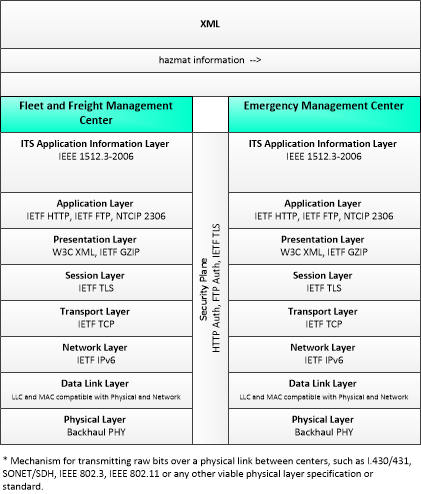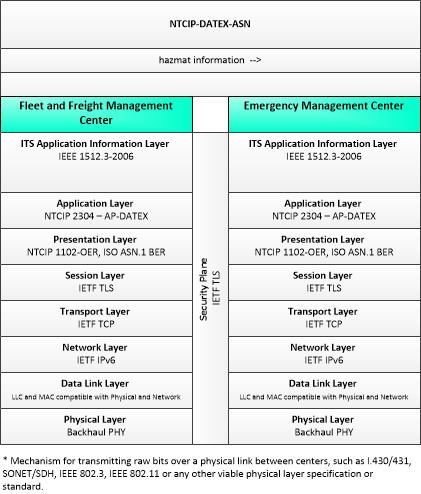Link Type: Center to Center
Fleet and Freight Management Center --> Emergency Management Center:
hazmat information
Definitions
hazmat information (Information Flow): Information about a particular hazmat load including nature of the load and unloading instructions. May also include hazmat vehicle route and route update information.
Fleet and Freight Management Center (Source Physical Object): The 'Fleet and Freight Management Center' provides the capability for commercial drivers and fleet-freight managers to receive real-time routing information and access databases containing vehicle and/or freight equipment locations as well as carrier, vehicle, freight equipment and driver information. The 'Fleet and Freight Management Center' also provides the capability for fleet managers to monitor the safety and security of their commercial vehicle drivers and fleet.
Emergency Management Center (Destination Physical Object): The 'Emergency Management Center' represents systems that support incident management, disaster response and evacuation, security monitoring, and other security and public safety-oriented ITS applications. It includes the functions associated with fixed and mobile public safety communications centers including public safety call taker and dispatch centers operated by police (including transit police), fire, and emergency medical services. It includes the functions associated with Emergency Operations Centers that are activated at local, regional, state, and federal levels for emergencies and the portable and transportable systems that support Incident Command System operations at an incident. This Center also represents systems associated with towing and recovery, freeway service patrols, HAZMAT response teams, and mayday service providers.
It manages sensor and surveillance equipment used to enhance transportation security of the roadway infrastructure (including bridges, tunnels, interchanges, and other key roadway segments) and the public transportation system (including transit vehicles, public areas such as transit stops and stations, facilities such as transit yards, and transit infrastructure such as rail, bridges, tunnels, or bus guideways). It provides security/surveillance services to improve traveler security in public areas not a part of the public transportation system.
It monitors alerts, advisories, and other threat information and prepares for and responds to identified emergencies. It coordinates emergency response involving multiple agencies with peer centers. It stores, coordinates, and utilizes emergency response and evacuation plans to facilitate this coordinated response. Emergency situation information including damage assessments, response status, evacuation information, and resource information are shared The Emergency Management Center also provides a focal point for coordination of the emergency and evacuation information that is provided to the traveling public, including wide-area alerts when immediate public notification is warranted.
It tracks and manages emergency vehicle fleets using real-time road network status and routing information from the other centers to aid in selecting the emergency vehicle(s) and routes, and works with other relevant centers to tailor traffic control to support emergency vehicle ingress and egress, implementation of special traffic restrictions and closures, evacuation traffic control plans, and other special strategies that adapt the transportation system to better meet the unique demands of an emergency.
Included In
This Information Flow is in the following Applications:
- Incident Scene Pre-Arrival Staging Guidance for Emergency Responders
- Incident Scene Work Zone Alerts for Drivers and Workers
This Information Flow is in the following Application Objects:
Communication Diagrams
The communication diagram(s) can be viewed in SVG or PNG format and the current format is SVG. Switch to PNG format.
This profile describes an alternative set of standards applicable to communications between entities using ISO TC204 WG9 DATa Exchange(DATEX). Information messages are encoded using the NTCIP Octet Encoding Rules (OER).
Characteristics
Architectural:
| Characteristic | Value |
|---|---|
| Time Context | Recent |
| Spatial Context | Regional |
| Acknowledgement | True |
| Cardinality | Unicast |
| Initiator | Source |
Security
This information flow triple is in the following applications with the following security levels.
| Information Flow Security | |||||
|---|---|---|---|---|---|
| Application | Confidentiality | Integrity | Availability | ||
| Basis | Basis | Basis | |||
| Incident Scene Work Zone Alerts for Drivers and Workers | High | High | High | ||
| This information could be of interest to a malicious individual who is attempting to determine the best way to accomplish a crime. Since hazardous material is by nature very dangerous, access to the routing, and load nature information could lead to a dangerous event. As such this information needs to be well protected. | If this is compromised, the EMC may not react properly to a hazmat incident, and thus assign inappropriate assets (too many, wrong type, not enough), leading to a longer or more damaging incident. | A delay in reporting this may cause a delay in getting the appropriate assets to the incident, or an over-commitment of assets. While the EMC may react to avoid the former by committing more assets than may be necessary, this in turn will create risk by making those assets unavailable to respond to incidents where they are truly needed. Such delays may be catastrophic for hazmat incidents. | |||

